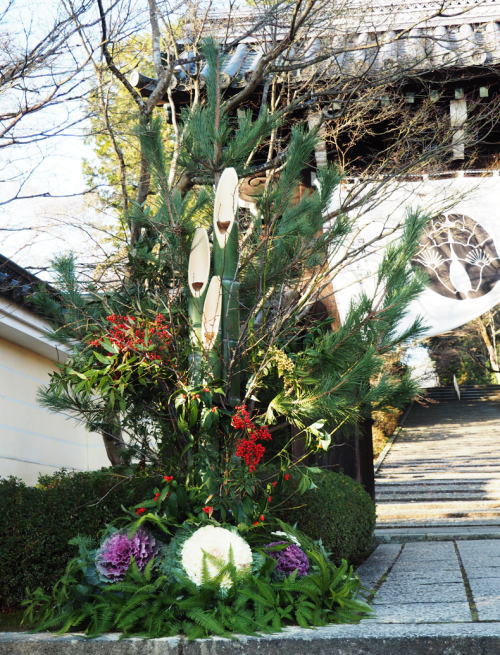 Kadomatsu decoration at Kōmyōji Temple, Nagaoka Kyo City, Kyoto
Kadomatsu decoration at Kōmyōji Temple, Nagaoka Kyo City, Kyoto
Walking on year-end or year-beginning days in Japan, you may find strange objects made of sharp-slashed bamboo tubes at the entrance of temples, shrines, and even in front of large houses. Look carefully. The cut-out bamboo trees are combined with other trees such as pine, red-berried nandina branches, and even pinkish cabbages! What are they? Why are they placed? “Let me guess...” you might say, “are they for welcoming fortune?” Or “To ward off evil spirits?” Nice try! Let me elaborate on the answer.
 Named as a principal item of Shōgatsu Kazari or New Year decoration in Japan, it’s called “Kadomatsu”, meaning “Pine at the Gate”. So, obviously, the main ingredient is pine instead of bamboo. But why the pine? First, the pine is an evergreen tree, and ancient people believed a divinity dwelled in the pine. Another reason is the Japanese word for pine says “Matsu”, which has the same sound as the word “Matsu-ru”, meaning “enshrine”. Pun intended, indeed. The Japanese people value the similarity of sound because an old Japanese myth says that even a sound has a spirit.
Named as a principal item of Shōgatsu Kazari or New Year decoration in Japan, it’s called “Kadomatsu”, meaning “Pine at the Gate”. So, obviously, the main ingredient is pine instead of bamboo. But why the pine? First, the pine is an evergreen tree, and ancient people believed a divinity dwelled in the pine. Another reason is the Japanese word for pine says “Matsu”, which has the same sound as the word “Matsu-ru”, meaning “enshrine”. Pun intended, indeed. The Japanese people value the similarity of sound because an old Japanese myth says that even a sound has a spirit.
Then, how about bamboo trees? Even though sidelined in the decoration name, it’s called “Take” and still a significant player of the auspicious decoration items in Japan, ranked number two following the pine. The third is the plum or “Ume”; some Kadomatsu decorations include blossomed plum branches. That celebratory triplet is valued as “Shō-Chiku-Bai”, representing the Chinese-style reading of Matsu, Take, Ume, respectively.
Digressing a bit, I have twin aunties, and guess what? Their names are Matsu-ko and Take-ko, namely, “Pine-Girl” and “Bamboo-Girl”. So, yes, you can say they are “Kadomatsu sisters”. I remember my childhood New Year’s day when I visited a shrine with them and how I was proud of my beautiful kimono-clad Kadomatsu aunties!
Let’s go back to the main theme. Why and What for Kadomatsu placed at the gate? Naturally, as a nation of Kamis (deities), Japan is home to a divinity called “Toshi Gami” (New Year's Deity). The Kami is believed to visit people’s houses, bringing good fortune. So, of course, you crave such a felicitous guest, and that’s where Kadomatsu becomes handy as a conspicuous marker. Technically called “Yori Shiro” or “the space to occupy”, the place where the deity descends is created by placing Kadomatsu.
Nowadays, ordinary houses seldom decorate real Kadomatsu, but miniature and even paper versions are available at supermarkets and 100-yen shops. So why don’t we get one and put it somewhere inside the house to attract good luck for ?

Kadomatsu placed in front of a shrine Torii gate.
|

Kadomatsu decorated at a rural railway station.
|

Kadomatsu placed in front of a shrine Torii gate.

Kadomatsu decorated at a rural railway station.
|

|




